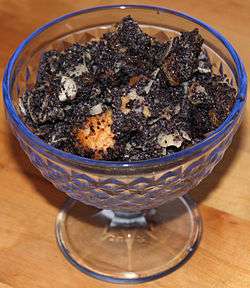Makówki
 | |
| Type | Dessert |
|---|---|
| Place of origin | Hungary |
| Region or state | Silesia |
| Main ingredients | Sweet white bread, poppy seeds, milk, butter, dried fruit (figs, raisins, apricots, dates), nuts, sugar, honey, vanilla, cinnamon, rum |
|
| |
Makówki, Lower Silesian: Mohn Kließla (Kliessla), Mohn Klöße, Mohn Pilen Hungarian: Mákos Guba are different names for a traditional poppy seed-based dessert from Central Europe. It is most notable in Silesia, where it is served almost exclusively on Christmas Eve (and perhaps on the following days, as long as the supply prepared for Christmas lasts).
Outside Silesia
Makówki is also well known in Brandenburg and Berlin under the name Mohnpielen [1][2][3][4][5][6][7][8]
A similar dish, but with slices of Kifli (Kipferl) in Hungary is called Mákos Guba.
Preparation
The main ingredient are: sweet white bread and finely ground poppy seeds boiled in milk with butter. Other important ingredients include: dried fruit (figs, raisins, apricots, dates, etc.) almonds and other kinds of nuts (the choice of nuts and dried fruit varies). It is flavoured with sugar, honey, vanilla, cinnamon and rum.
The bread is cut into thin slices and layered in a clay pot or more often into a glass or crystal bowl. After each layer, the sauce of the boiled poppy seeds, with flavouring and nuts, is poured so that the bread is well soaked. The top is decorated with some extra nuts and fruit. The dish is served cold, at least several hours after preparation.
Significance in Silesia
Silesian cuisine can be very conservative. The tradition of makówki/mohnkließla/mohnpilen is well maintained amongst Silesians, i.e., it is hard to imagine a Silesian Christmas without this foodstuff, and it would be rather unorthodox to serve it outside the Christmas—New Year period. Preparing makowki outside Silesia can be a challenge because of unavailability of finely ground poppy seed (a special mill is usually required). In the U.S.A., canned poppy paste is sometimes commercially available and can be used.
In art
Theodor Fontane in his travels through Mark Brandenburg wrote about Mohnpielen[9] and other dishes.
See also
Notes
- ↑ Mohnpielen in books by 1900
- ↑ Book from 1836, Mark Brandenburg, Mohnpielen
- ↑ 1862 book: Northern Germany, Germanic Mythology, to eat seeded foods (particularly Mohnpielen) to ward off bad spirits during twelve days frost
- ↑ Brandenburg Mohnpielen, 1868 book
- ↑ 1885 book: Mohnpielen], Die Familie Buchholz, Julius Stinde
- ↑ 1899 book, Mohnpielen Brandenburg Heimatkunde –Regional history
- ↑ Mark Brandenburg Mohnpielen Georg, Rietschel, 1902 book
- ↑ Paul Drechsler, Sitten und Braeuche in Schlesien, in Brandenburg, Mohnpielen 1903 book
- ↑ Theodor Fontane, Mohnpielen and other dishes
External links
| Wikimedia Commons has media related to Makówki. |